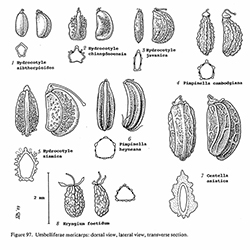e-Flora of Thailand
Volume 5 > Part 4 > Year 1992 > Page 449 > Umbelliferae > Eryngium
Eryngium foetidum L.wfo-0000677912
Sp. Pl. 232. 1753; C.B.Clarke in Schmidt, Bot. Tidsskr. 24: 248. 1902; H.Wolff in Pflanzenr. 61. IV. 228: 203. 1913; Ridl., J. Straits Branch Roy. Asiat. Soc. 59: 108. 1911; Craib, Kew Bull. 1911: 58. 1911; Hosseus, Beih. Bot. Centralbl. 28. 2: 420. 1911; Ridl., Fl. Malay Penins. 1: 870. 1922; Chermezon in Fl. Gén. I.-C. 1140. 1923; Craib in Fl. Siam. En. L: 788. 1931; Kanjilal et al., Fl. Assam 2: 340. 1938; Buwalda in Fl. Males., Ser. 1, Spermat. 4: 126, fig. 5, 1949; Hiroe, Umbell. Asia 1: 197. 1958; Hiroe, Dansk Bot. Ark. 20: 195. 1962; Back. & Bakh.f., Fl. Java 2: 174. 1965; Tard.-Blot in Fl. C.L.V . 5: 28. 1967; Liou Shou-lu in Fl. Reip. Pop. Sini. 55. 1: 64, fig. 28. 1979. Fig. 97: 8.
Accepted Name : This is currently accepted.
Description : Erect foetid biennial, 6–35 cm high; stem to ca 20 cm high, grooved. Basal leaves rosette-forming, 3.5–16 by 1–3.5 cm, entire, narrowly elliptic to obovate, apex obtuse, margin regularly spinose-dentate, ± sessile to shortly and broadly petiolate. Cauline leaves up to 6.5 by 1.5 cm, restricted to base of inflorescences, entire or palmately divided, prominently nerved, spiny. Inflorescences much branched. Floral leaves 2–3 cm long, obovate to rhomboid, trisect or palmatisect. Peduncles 1–5(–10) mm long. Bracts ca 5, 1–2.5 cm long, narrowly elliptic, ± entire with a few spinose teeth, apex acuminate. Capitulae 4–10 by 3–4 mm, compactly flowered, ovoid to cylindrica 1. Bracteoles ca 1.5 mm long, ± membranous. Sepals ca 0.5 mm long. Petals inconspicuous up to ca 0.8 mm, whitish. Fruit 1–1.5 mm long.
Thailand : An introduced weed; NORTHERN: Chiang Mai (Doi Inthanon, Doi Chiang Dao, Tham Chiang Dao, Doi Suthep, Bo Luang, Fang), Chiang Rai (Doi Tung), Mae Hong Son (Mae Sariang), Lamphun (Doi Khun Tan), Phitsanulok (Thung Salaeng Luang); CENTRAL: Krung Thep Maha Nakhon (Bangkok); SOUTH-EASTERN: Chanthaburi (Makham to Soi Dao, Khao Sabap), Trat (Ko Chang); SOUTH-WESTERN: Prachuap Khiri Khan (Bang Saphan Noi).
Distribution : Tropical America (type), introduced and widely spread in E & SE Asia from India and China south to Java, also tropical Africa.
Ecology : A weed of dry meadows and forests, probably more widespread than the records would suggest. Known as an escape from cultivation since the end of the nineteenth century, sea level to 1,450 m alt.
Vernacular : Phak chi farang (ผักชีฝรั่ง)(Central); phak chi doi (ผักชีดอย), hom pom kula (หอมป้อมกุลา)(Northern).
Uses: Leaves eaten raw with rice or to flavour soups and curries, but also recorded as of medicinal value.
Notes: A form with conspicuous upper bracteoles, forming a coma at the top of the capitulum (f . comosum Urban in Mart. & Eichler, Fl. Brasil. XI, 1: 302. 1879) is found in the New World, but none of the SE Asiatic specimens seen possesses such a coma.

